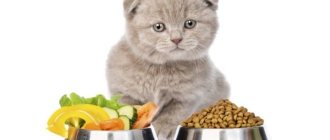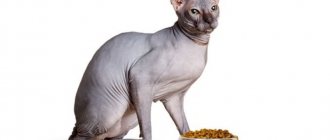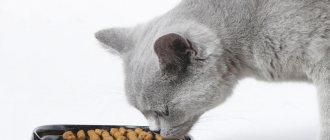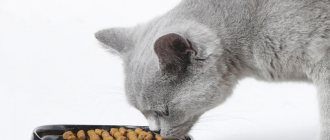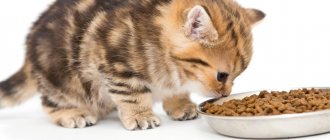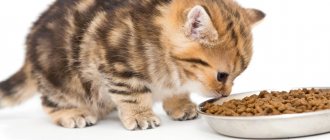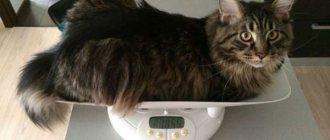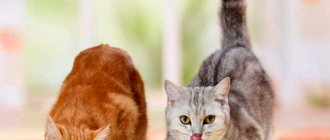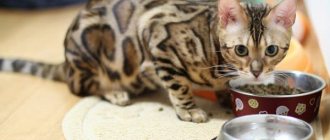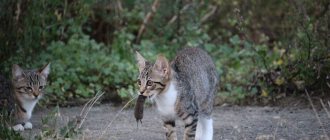Purebred kittens are very picky about their diet. This ordinary cat can be fed soup or bread, and it will be satisfied. In order to raise a Scottish cat that corresponds to the breed characteristics, you should take care of its nutrition from the moment of planned conception. It is very important that the cat from whom you plan to have offspring eats adequately before mating, during pregnancy and several months after the birth of the babies. The milk feeding period is important for the proper functioning of the gastrointestinal tract of babies. When trying to find out what to feed Scottish kittens, there are several important points to consider.
Types of food
There are several options for feeding cats:
- natural, when the pet is offered a choice of meat, fish, minced animals;
- feeding with industrial feeds. These can be dry treats or jelly-like canned foods;
- mixed option, but it is not recommended to literally mix dry food and natural products. For breakfast there can be canned food, and for dinner a full-fledged minced chicken cutlet.
Veterinarians do not recommend using a mixed version, citing the fact that in this case it is difficult to avoid an overdose of vitamin supplements. An imbalance of vitamins and minerals in the body causes disturbances in the functioning of the body. Also, with mixed feeding, animals often experience digestive disorders and constipation, which can lead to diseases of the gastrointestinal tract.
The choice of food depends on the owner’s employment, their financial capabilities, and the pet’s taste preferences. It should be remembered that the diet should be varied, but at the same time balanced. Obesity is dangerous to the health of any cat. Problems with excess weight arise if the owners do not control the calorie content of their dishes and indulge their constantly meowing pet.
It is best to feed animals according to a schedule and a pre-compiled menu. Neutered cats are usually found with the problem of excess body weight, so special attention is paid to their diet.
Many pet owners argue about the correct choice of food. Some insist on a natural diet, others say that industrial feed is much healthier and tastier. It is difficult to prove anyone is right in this situation. Feeding natural foods is problematic for many. This requires frequent trips to the market or store. Meat and fish must be fresh.
In addition, fresh meat and fish delicacies may contain worm larvae, which can lead to the development of helminthiasis. To avoid infection, you will need to boil or bake a dish for cats, because fried food is harmful not only to the human body, but also to the cat’s stomach.
Ready-made food does not take much time to feed. It is enough to pour a certain portion to clearly know that your pet will not go hungry until the evening.
Caring for an old pet
The aging body of a Scottish cat is more susceptible to various diseases than young individuals. During this period of time, arthritis may develop, the pet’s behavior may change, and problems with the functioning of the stomach and intestines may arise.
To avoid problems, you should select food that is appropriate for the age of your pet. Conduct a preventive examination of the cat with a veterinarian and monitor the health and emotional state of the Scottish cat.
After a walk, the cat is checked for ticks and fleas. Often the Scots do not walk outside, they stay in the apartment, but if the pet is taken outside the house, a subsequent examination is necessary.
General feeding rules
Typically, kittens are purchased at the age of 3-4 months, when their body is able to do without mother’s milk and is partially accustomed to new “adult” food. To correctly create a menu and feed your baby, you need to take into account a number of factors:
- The baby's stomach is very small, and activity is increased, so feeding should be frequent and portions small. For example, at the age of 3 months, a kitten is fed 5-6 times a day, and an older 4-month-old baby needs to be fed 4 times a day;
- a pet that does not have enough food will develop poorly, lag behind its peers, and often get sick;
- overfeeding is also dangerous. Unspent calories will definitely lead to obesity and disease;
- new products are introduced gradually, starting with small portions. Feeding with different foods must be alternated, that is, meat for breakfast, fish for lunch, cottage cheese for dinner. This is how the stomach learns new tastes and gradually gets used to them;
- You can’t pour the entire daily portion into your baby’s plate. His stomach is not yet able to control itself, which is dangerous due to overeating;
- food should not be too hot or cold. The kitten may get burned or have a cold in its throat. It is advisable to slightly warm foods before feeding.
What to look for when buying a Scottish Fold cat
You can buy Scottish Folds through advertisement sites, at an exhibition or in a certified nursery.
The next class is “breed”. These cats are potential breeders from whom you can expect worthwhile offspring. And finally, the most expensive class is “show”. These animals have every chance to compete for prizes at exhibitions. Moreover, such a high status must be confirmed not just by words, but by exhibition certificates.
Another important point is the health of the future pet. Therefore, when choosing, you should carefully examine the kitten. Severe thinness, bald patches, fleas, and an overly swollen abdomen may indicate improper care and dishonesty of the breeder. In addition, some behavioral features of Scottish Folds may be signs of a genetic disease that affects bone and cartilage tissue. So, if the paws and tail are inactive, and the kitten itself cannot run and jump normally, it is better to refrain from purchasing it.
Features of a natural diet
Not all natural products can be used for the daily menu of Scottish kittens. The main list of permitted products is as follows:
- Beef is used raw or boiled. If the owners chose the first option, it is recommended to pre-freeze the meat. Many worms die from subzero temperatures. Kittens can be given meat from the age of 3 months. The portion should be small: approximately 30 g per feeding.
- Chicken breast. It is best used boiled and crushed. The portion should also be small; you can feed it from 2 months.
- The liver causes diarrhea in small kittens, so it is included in the diet occasionally (no more than once a week) and in small portions of 10-15 g, always boiled.
- Fish should be present in the diet, but not as a daily three meals a day. Use low-fat fish (for example, hake, blue whiting, carp, perch). Before feeding, the fish is boiled, the bones are removed, and you can grind it in a meat grinder until it becomes minced meat. Excess fish in the diet creates problems with kidney function.
- Egg yolk is introduced into the diet occasionally (1-2 times a week).
- Milk often causes stomach upset in adult cats, so it is better to include fermented milk dishes in the diet - kefir, low-fat cottage cheese, sour cream, fermented baked milk. Usually cats love this treat. You can pour a little kefir into a saucer at night, even if the kitten gets hungry, this feeding will allow it to last until the morning.
- Milk porridges are used to feed small kittens (up to 6 months). It could be semolina porridge or oatmeal, chopped buckwheat. Older pets should eat a side dish with butter or vegetable oil, but without milk, to avoid indigestion.
- Cereals (rice, buckwheat, egg, semolina, oatmeal) can be used together with a meat or fish dish. Cats are still predators, so the proportions must be observed: meat or fish - 2/3, side dish - 1/3. The side dish is added to the portion several times a week.
- Vegetables and herbs should also be present on the four-legged pet’s menu. This could be special grass, carrots, cucumbers, cauliflower. Vegetables are boiled, pureed and added to minced meat. Some cats express a desire to eat fresh vegetables and fruits (for example, cucumbers, melons, pumpkin). There is no need to interfere; perhaps the kitten has a lack of some vitamins in the body.
Fermented milk products should be used separately from the main menu. There is no need to add kefir to porridge or meat. Cottage cheese can be mixed with sour cream and served as an afternoon snack; kefir or fermented baked milk can be left overnight.
Need for vitamins
The menu for Scottish kittens should additionally include vitamins A and D. Veterinary pharmacies purchase special multivitamins for Scottish kittens or regular fish oil. This will saturate your small pet’s body with the necessary vitamins and microelements.
Drinking regime
A bowl of water should be in the baby’s constant access. This way he gets used to drinking the amount of water necessary for normal functioning. Scottish kittens are so spoiled that they will have to change their water twice a day. Any speck becomes a nuisance, and the baby looks for another place to quench his thirst.
Many pets get used to drinking only from the tap. Therefore, it is advisable to install a filter on the water supply system in your house or apartment.
List of harmful foods
There are foods that can harm the health of Scottish kittens:
- Pork is the main source of helminthiasis, so it is better to avoid feeding pork. There are two more compelling arguments why pork is harmful to cats. This is very fatty meat. In addition, this is the source of Aujeszky's disease. Pigs are considered the hosts of the pseudorabies virus. The virus is not dangerous for people, so the meat of slaughtered animals is not examined for virus carriage. A cat can become infected with false rabies by eating pork. The virus is deadly for kittens. Animals older than 1 year can cope with the disease, but this is done with great difficulty and not without the help of veterinarians. Only individuals with strong immunity survive.
- It is not recommended to include fats in the diet of kittens.
- Smoked and salty foods are extremely dangerous for children.
- You should not pepper, salt, or add various seasonings and spices to cats’ dishes; this can spoil the cat’s sense of smell and cause irreparable harm to health.
- Sweets and starchy foods are harmful to a growing body. Buns, cakes, ice cream, sweet drinks, and candies can disrupt metabolic processes in the body and cause obesity. Cats do not taste sugar, so they are able to eat a huge amount of treats. A regular excess of sugar in the diet causes disruptions in the functioning of the pancreas, which provokes the development of diabetes. Diabetes causes vision problems. The disease is accompanied by a sharp deterioration of vision or blindness. Chocolate contains theobromine, an alkaloid that causes a rise in blood pressure, excitement and an elevated pulse. A piece of sweet treat can turn into such a nuisance for your baby as severe theobromine poisoning. In the future, such experiments with nutrition can lead to cardiovascular pathologies. Urolithiasis occurs not only when a pet is addicted to fish. Sweets also cause kidney overload, which leads to the development of kidney diseases. Pregnant cats eating sweet buns can give birth to kittens with deformities. A passion for sweets leads to intrauterine fetal death and stillbirth. Dishes with sugar are dangerous for the development of an allergic reaction in kittens.
- Chicken bones can cause gastrointestinal injuries. When chewed, tubular bones form sharp edges that can pierce the stomach and cause inflammation, perforation, and peritonitis.
Recommendations for 1-3 months
Cats are naturally very clean creatures and do not normally require additional care. However, due to their age, kittens do not always cope with their hygiene procedures, and they need help with this.
Behind the eyes
Kittens need to regularly clean their eyes with a damp cotton pad (by the way, for Sphynx cats this is a different story altogether). You should be accustomed to such procedures from a very tender age and from the first days of the kitten’s stay in the apartment. Once a week, to prevent infections and cleanse your eyes more thoroughly, you can wipe them with a solution of boric acid (1/2 teaspoon of dry powder per glass of boiled water).
Nail trimming
Domestic kittens should only have the claws on their front paws trimmed. It is also worth accustoming to the procedure from the first days of life with the owners. Nails are trimmed approximately once a month - only the very tip is trimmed, no more than 2 mm, so as not to touch the blood vessels.
When to bathe and how?
Kittens are bathed only if necessary - if they are heavily soiled or if the presence of fleas is suspected. Fold-eared kittens are not allowed to bathe until they are two months old. Then bathe once every two to three months. Bath in warm water with special shampoo. After bathing, the coat must be dried to avoid hypothermia and colds.
The vast majority of kittens are afraid of the sound of water, so you should be careful with the pressure. It is better to fill the bathtub or basin with water in advance and water the baby from a ladle. For training, you can put rubber toys in the water.
The ears must be covered with cotton swabs during bathing. Oil drops are instilled into the eyes to prevent irritation of the mucous membrane in case of accidental contact with soapy water. The temperature should be about 36oC.
You need to wash all the products very carefully, because even after washing and drying the kitten will lick itself to remove the specific smell. Hot air is not used to dry the fur - only cold air at a distance of about half a meter from the kitten.
Ear cleaning
Ear inspection and cleaning should be done at least once a week. The auditory canal is carefully wiped from the outside with a cotton pad or cotton wool twisted into a flagellum.
It is better not to use cotton swabs - the kitten may pull away from the unpleasant sensations, and the swab itself may damage the ear, or the cotton swab from it may remain in the ear canal. Wax from the depths of the ear is not removed.
Scottish Fold coat care
Scottish Folds are naturally very clean and take care of their fur themselves. However, to reduce the clogging of the stomach with hairballs, you need to regularly, at least once a week, comb the animal with a special hair brush.
You can purchase them in special veterinary stores or pharmacies. For short-haired subspecies, a brush with short and frequent teeth is used; for long-haired counterparts, combs should have longer and sparse teeth.
Also, long-haired cats need brushing at least once every two to three days. During the molting period, brushing is carried out more often.
Feeding frequency
The number of feedings depends on the age of the kitten. The approximate diet and number of feedings per day are presented in the table (on a mobile device you can scroll the table horizontally with your finger):
| Pet's age, months. | Number of feedings | Example of products and dishes used |
| 1 | 6-8 | Warm milk semolina porridge, baby formula, a small amount of boiled chicken yolk. |
| 2 | 5-6 | Low-fat cottage cheese, milk, semolina porridge, a small portion of boiled and chopped meat (10-15g). |
| 3 | 4-5 | Boiled minced meat, cottage cheese, kefir, chopped vegetables, baked or boiled fish, porridge. |
| 4-6 | 3-4 | Fermented milk products, meat, minced meat, cartilage, fish, fresh and boiled vegetables. |
| over 6 | 3-2 | All permitted products. |
Menu options
Feeding your Scottish Fold kitten tasty and healthy natural food will not be difficult if you prepare balanced meals for it in advance using simple recipes:
- You need to take 75 grams of raw beef and 15 grams of lungs, pour boiling water over the products and chop them. To the meat mass you need to add 30 grams of water, 6 grams of vegetable oil, 0.6 grams of dry yeast and 12-15 grams of cooked oatmeal flakes. Mix all ingredients until smooth.
- Finely chop 30 grams of low-fat liver and mix with 75 grams of low-fat finely chopped fish. Add 12-15 grams of boiled buckwheat, 20 grams of water, 0.3 grams of yeast to the products. Mix everything until smooth.
The ingredients in the above recipes are for one serving of food for a 3 kg cat (or three servings for a 1 kg kitten). In order not to waste time on cooking every day, the owner can prepare a large amount of food in advance, divide it into parts (portions) and freeze it in the freezer. When the pet gets hungry, all the person needs to do is defrost the food and put it in a bowl.
Advantages of ready-made feeds
Why are more and more owners of kittens switching to ready-made food? Perhaps the secret is that everyone wants to have a kitten, but there is simply no one to care for and feed it. Constantly being busy at work means that owners have no time to boil meat, fish, or grind food to remove bones.
Ready-made food has many advantages. Premium mixtures are designed for feeding cats, taking into account their age, body type, belonging to a specific breed, and are even available for neutered and lactating pets.
Popular foods that are suitable for Scottish babies:
- Wahre Liebe "Junge", produced in Germany. The food contains colostrum, so the product is well absorbed and can be used for feeding from the earliest months. In addition, the food contains chicken and turkey meat, as well as rice, egg and beet pieces. The manufacturer assures that the food can be used to prevent urolithiasis.
- Fans of the fish menu will appreciate Hill's Science Plan Kitten Tuna - dry food, made in the USA. It contains: floured tuna meat, chicken, animal fat, flaxseed, corn, beets, fish oil, Omega-3 and Omega-6 acids. Kittens really like the food. Long-term use helps strengthen the immune system.
- Canadian manufacturers offer high protein dry food 1st Choice Kitten. It contains, in addition to chicken and herring meat, rice, barley, oatmeal, egg powder, tomato and beets. The food is hypoallergenic, therefore suitable for pets suffering from food allergies.
- Another dry food from French manufacturers is Royal Canin British Shorthair Kitten, containing dried poultry meat, extract from cartilage and crustacean shells, fish oil, corn, and chopped beets. According to the annotation, the food is a preventative against joint pathologies.
- For lovers of wet food, the French offer Royal Canin Kitten Instinctive. In addition to meat and meat products, it contains cereals, yeast and milk.
- The manufacturer Purina Pro offers Plan Dental Plus food for small kittens. The unique composition allows you to maintain your pet’s oral cavity in excellent condition. The food prevents the formation of dental plaque.
- Hills high carbohydrate food is designed for active kittens. It contains calcium and magnesium, which the baby needs for full development. The food is not suitable for overweight kittens.
The calorie content and consumption rate must be indicated on food packages, so you must follow the manufacturer’s recommendations. The average norm for a Scottish kitten is 200 kcal.
Ready-made food is divided into the following types:
- dry;
- wet;
- semi-moist.
When choosing dry food, you need to remember about constant access to a drinking bowl, otherwise the cat will have problems with bowel movements.
Dry and wet formulations from the same manufacturer are allowed to be used for mixed feeding. At the same time, they are not combined into one feeding, but distributed alternately:
- one feeding – dry portion;
- second feeding - wet canned food.
Dry food must be stored properly. Before purchasing a package of food, you should pay attention to the following points:
- expiration date and storage conditions;
- manufacturer's brand and type of food (it is best to choose a premium and holistic line);
- the age of the pet indicated on the packaging and actual age;
- special additives. The food may contain increased amounts of certain microelements and vitamins. Feeds are not only balanced, but also medicinal. Not all kittens need special food, so you should pay close attention to the instructions on the food.
What is prohibited
- Never feed this breed bones.
- They are also contraindicated in fatty, salty and seasoned foods. This will cause considerable harm.
- Do not feed kittens spoiled food or dry food that has already expired.
- The benefits of milk for kittens of this breed are very doubtful. The animal's body may not accept this product well. Sometimes it may not be digested. Since it contains lactose, fermentation processes can begin in the body. As a result, the functioning of the stomach will be disrupted, which will cause unpleasant symptoms and pain in the animal. Instead of milk, it is better to give other dairy products that were listed above. If you still want to give your pet milk, it is better to do this only occasionally.
- It is still advisable to boil the meat. An adult cat can easily eat a raw product, but it can cause indigestion in a kitten. In addition, the product may be of poor quality. Due to the consumption of raw meat products, animals often develop toxoplasmosis.
Artificial feeding of a newborn kitten
Usually babies up to 1-3 months are fed by a mother cat. There are situations when the offspring is left without a mother, and a person takes on the role of nurse. This is a very important mission, which sometimes seems impossible. Nothing is impossible, the main thing is desire and skill. The best option is to ask your friends if they have a nursing cat. Usually the mother does not refuse to feed her foundlings.
If this option is not available, start feeding from a pipette. Before feeding, babies are weighed, this allows you to determine the required amount of food. A 100-gram baby will need 30 ml of formula or milk, which is how kittens are fed during the first week after birth.
Starting from the second week, the nutritional intake is increased. For every 100 g of baby's weight, at least 38 g of liquid food is needed. In the third week, at least 48 g is already required. Starting from the next month, the norm increases to 53 g.
During the first month, the baby should receive food multiple times (up to 10 times a day). For feeding, warm milk or cream is used, which is poured into the baby’s mouth using a pipette or syringe without a needle. This must be done carefully so that the kitten does not choke.
Cow's milk is slightly different in composition from cat's milk. For example, there is less water in cat milk (70%) than in cow milk (88%), and the fat content is higher - 11% and 3.25%, respectively. But the most important difference is the amount of lactose. There is almost 2 times more of it in cow milk (5.2%) than in cat milk (3%).
The pet store sells a special formula for newborn kittens, which is similar in composition to a cat's mother's milk and is more suitable for feeding babies than cow's milk.
How to feed
You need to know that feeding representatives of this breed with packaged food should be accompanied by their advance soaking with water, milk or curdled milk. In addition, for the first time after the baby is delivered from the nursery, he should be treated as he was fed there.
If there is a sudden change in feeding schedule, or if new food is immediately offered, the kitten may experience indigestion. It is better to avoid such troubles for your pet in every possible way.
Conscientious nurseries give the new owner a package of food and pellets for the tray. This allows the kitten to get used to a completely new environment more easily and in a shorter period of time.
Scottish Straight babies and adults require dairy products. So it would be good to treat them with milk, yogurt and cottage cheese from time to time. It is not recommended to offer cream with sour cream; it is hard on the cat’s liver.
Natural foods suitable for this breed:
- liver and heart;
- lean beef and chicken;
- dairy products;
- herbal ingredients;
- a little vegetable oil, they need to be seasoned with stewed and boiled vegetables before serving.
It should be remembered that Scottish Straights require moderate nutrition! In no case should you give too much, no matter how many months or years old they are, in order to avoid excess weight and poor health in your pets (see table of Scottish kitten weight by month). Thoroughbred animals should have medium size and smooth outlines.
Norm kJ, calories (energy consumption) for kittens and adult pets
According to the rules, the norm of kJ and calories must be calculated based on the pet’s weight and lifestyle, so the data below refers to approximate indicators that can be used as a guide:
- for a baby – 838 kJ (200 kcal);
- for a nursing Scottish woman – 1047.4 kJ (250 kcal);
- for a pregnant and developing household – 419 kJ (100 kcal);
- for an obese cat - 251.4 kJ (59.9 kcal);
- for an aging furry – 335.2 kJ (80 kcal).
Information about the calorie content of foods can be found on food packages. In order to convert kJ into calories, the required figure should be divided by 4.19. The colors and types of Scottish cats may be different, but no matter what color they are, the diet must be balanced in order to maintain their vital functions at the proper level. Then your pet will always be healthy and beautiful.
